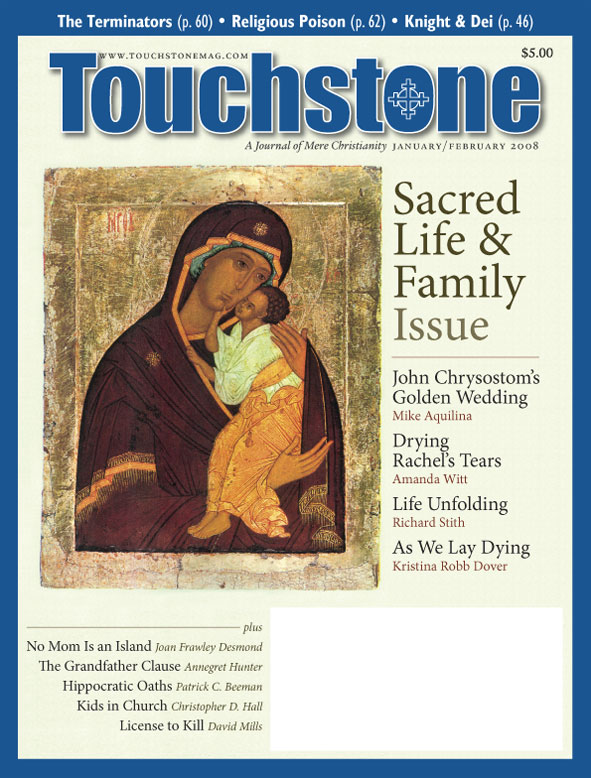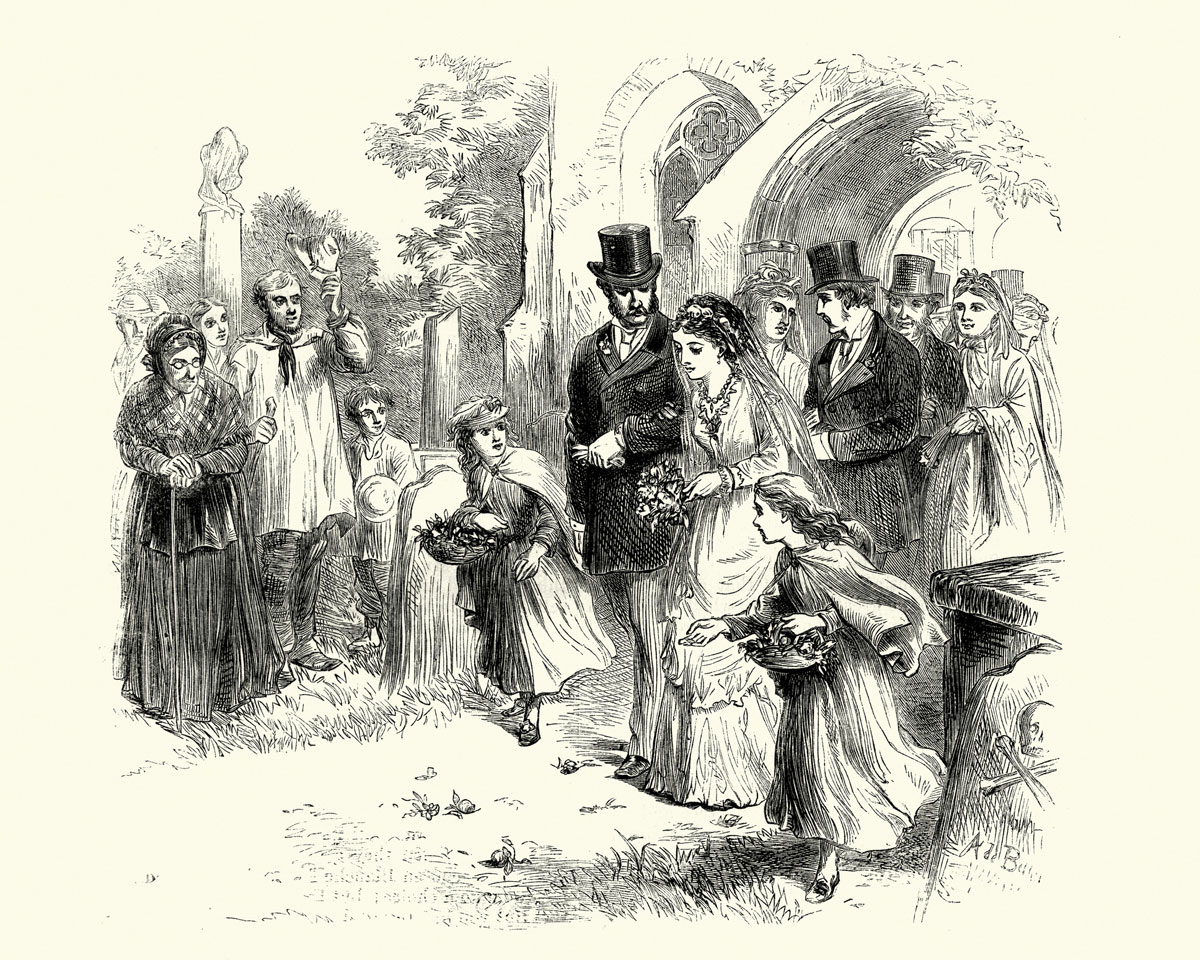Arresting Development
Human Beings Don’t Roll Off an Assembly Line
by Richard Stith
Think of a car on an assembly line. At what point in the line would we first say, “There’s a car”? Some of us would no doubt go with appearance, saying there’s a car as soon as the body is fairly complete.
Most of us would look for something functional: We would say there is a car only after a motor is in place, or the wheels, or even the wipers (so it can be driven even in the rain). And a few might say, “It’s not a car until it rolls out onto the street.” But nobody is going to say “There is a car” at the very beginning, when the first screw or rivet is put in or two pieces of metal are first welded together.
I think this is exactly the way many people see the embryo. As a New York University sociologist, Dalton Conley, noted in the New York Times, “Most Americans . . . see a fetus as an individual under construction.” In the first stages of construction, you don’t have a car; neither do you have a human individual. You don’t ever have what you’re making when you’ve just started making it.
This does not mean that our “constructivist” friends are anti-life. They may believe that a baby should have absolute protection once it’s been fully fabricated. But until that point, for them, abortion just isn’t murder.
Unconstructed Man
What happens when a constructivist hears a pro-lifer argue that a human embryo has the same right to life as any other human being? Let’s listen to a couple of commentaries on President Bush’s opposition to embryonic stem-cell research, research in which human embryos are killed in order to obtain their stem cells.
Writing in the Washington Post, Michael Kinsley expressed his utter bewilderment: “I cannot share, or even fathom, the [pro-life] conviction that a microscopic dot—as oblivious as a rock, more primitive than a worm—has the same rights as anyone reading this article.”
Writing on the website The Huffington Post, Geoffrey Stone took a common next step, the accusation of an improper religious doctrine. The President, argued this University of Chicago law professor, referred to the “conflict between science and ethics,” and clearly
the “ethical” side of this conflict derives from the belief that an embryo smaller than a period on this page is a “human life”—indeed, a human life that is as valuable as those of living, breathing, suffering children. And what, exactly, is the basis of this belief? Is it Science? Reason? Logic? Tradition? Morals? None-of-the-Above? What the President describes neutrally as “ethics” is simply his own, sectarian religious belief.
I doubt very much that Stone investigated the President’s Methodist faith and discovered that its creed included the protection of embryos. His allegation appears to come at the end of a process of elimination. If science, reason, and the like can’t explain the President’s action, he must be basing his decision on some sort of supernatural belief.
There’s a deep truth in Kinsley’s puzzlement and Stone’s leap to faith. Nothing can be a certain kind of thing until it has the form of that kind of thing, and a thing under construction does not have its form because the persons or forces constructing it haven’t yet shaped the raw material into what it will be.
But the construction metaphor is radically mistaken about the nature of gestation. It is not true that living beings are constructed, by God or by anyone else. Life is not constructed. Life develops.
In construction, the form defining the entity arrives only slowly, as it is added from the outside. In development, the form defining a life (that which a major Christian tradition calls its “soul”) is within it from the beginning. If Corvette production is cancelled, the first two pieces of metal stuck together can become the starting point for something else, another kind of car or a washing machine. But if you take a human embryo out of the womb, you can never get it to develop into a puppy or a guppy.
Man Unveiled
Life is not formed or defined from the outside. Life defines and forms itself. Its form or nature is there, in its activated genes, and begins to manifest itself from the very first moment of its existence. The only things embryos need are food, oxygen, and protection from external hazards, not form. They don’t need to be molded into a type of being. They already are a definite kind of being.
This idea of development—as the continual presence but gradual appearance of a being—lies deep within us. Look at the word “development” itself. To “de-velop” is to unwrap, to unveil. It is the opposite of “en-velop.” In development, we unwrap or unroll or unfold, we make manifest, that which was previously rolled or wrapped or folded up and thus veiled from sight. In other words, outward appearance tells us much less about the identity of a developing creature than it does about the identity of something under construction, which is one of the reasons it is wrong to confuse the two.
Suppose you have taken a Polaroid picture of a jaguar darting out from a Mexican jungle. The jaguar has now disappeared, and so you are never going to get that picture again. As you are waiting for it to develop, I grab it and rip it open, thus destroying it. When you get angry at me, I just say blithely, “You’re crazy. That was just a brown smudge. I cannot fathom why anyone would care about brown smudges.” You would think I was the insane one. Your photo was already there. We just couldn’t see it yet.
That is just what pro-lifers think when people say, “How can a microscopic dot have the same rights as a reader?” That microscopic embryo is a human being in the first stage of its development. We each started off looking like that. But we each have been the same organism and the same kind of being at every stage of our development.
The nature of development is the reason the German Constitutional Court has twice held that there is a right to life throughout pregnancy. That court emphasized in its opinions that the unborn child is “self-developing” and therefore cannot be said to come into being at some stage, as might happen with a thing being constructed.
The court also pointed out that almost all of us adopt the developmental understanding of life once a child has been born, for the peculiarly valuable characteristics we identify with humanity (e.g., reason, free choice, love) do not appear until some time after birth. Thus, if the newborn infant were thought of as being constructed, we would have to say that he is not yet human until he shows those traits. But we give him “credit” for those traits long before he shows them, because we know they are already part of his nature, are already developing within it.
The Mistaken Middle
Now how does this tie in to the debates over abortion and embryonic stem-cell research?
Many, even many believing Christians and Jews, base their aversion to abortion on a reverence for God’s work-in-progress, rather than on the idea that abortion is murder. Conley, for example, did not argue that the fetus had no value because it was still under construction. He claimed, rather, that the fetus has value precisely as “an individual under construction.” It has value as an important work-in-progress.
In other words, abortion may not be murder, because a human individual has not yet been constructed, but it is not good to destroy anything well on the way to being something we really care about. We would feel bad about destroying a Corvette-to-be even part way through its construction. Suppose I destroyed a colleague’s paper when he was only a third of the way through it. I would have done something bad because it was a meaningful work-in-progress.
I think that explains much about the feelings of those who say that there is something wrong with abortion but that it is not murder. After all, the Bible talks many times about God forming us in the womb. Job exclaims, for example, “Thou didst clothe me with skin and flesh, and knit me together with bones and sinews.” It might be very wrong to interrupt God’s awe-inspiring construction project, but it can’t count as murdering a human being if he hasn’t yet been knitted together.
Of course, such a believer might see the bodily form as having been completely assembled by ten weeks or so, when all the organs are in place—so that later-term abortion would count as murder. That is, one might view gestation as construction only early in pregnancy.
In other words, though biologically incorrect, the construction model of gestation can lead to a certain valuing of the fetus as a work-in-progress. In this sense, the mistaken middle position helps to moderate the debate over abortion.
The Developed Embryo
The clash of the constructivist model with the developmental model is much greater with regard to embryo research than it is with regard to abortion. Both models find something to regret about abortion. But they split radically with regard to the killing of extra-uterine embryos.
Pure constructivists care little or nothing about embryos killed just after having been conceived or cloned in a test tube. Never even having been works-in-progress, such embryos, they’d argue, lack any relationship to a future human form, or to their parents, and can just be used as scrap.
But developmentalists would argue that the identity of a developing human being remains constant from his very beginning. The value of that jaguar photo changes hardly at all from the time it’s snapped to the moment it’s fully developed.
Thus, from a developmental viewpoint, embryonic stem-cell research is not less but more dehumanizing than abortion. The unborn child’s human dignity is far more radically negated by such research than it is by abortion. Embryos subject to research are first commodified and then destroyed for body parts. No one mourns their deaths, though they are just as much our younger brothers and sisters as are human beings at other stages of development—such as fetuses, infants, toddlers, and teenagers.
The clash of the models may also help us understand our mutual misunderstandings about euthanasia. If a Corvette is gradually dismantled, it eventually ceases to merit the appellation “car.” Corvette-lovers might still have a certain reverence for the body, or even for a piece of the frame, because it used to be part of the car, so that trashing it for no good purpose would still seem to them wrong. But it wouldn’t seem nearly as wrong as destroying the actual car itself.
Life, however, is different. The form (nature, design) of a living creature both precedes and perdures independently of its appearance and function. That activated form is imbedded within a living being’s every part and every cell (in its active DNA). As long as a disabled creature remains alive—that is, as long as it holds itself together in some way, rather than just becoming a collection of non-integrated objects—it remains what it always was from the beginning of its development.
Terri Schiavo remained a human being until the moment she died of dehydration, because every part of her wasted body (from her genes to her shrunken tongue) actively, though in vain, strove to express her natural reason, will, and connection to those she loved. She never became something else, such as a vegetable.
That is why her condition was tragic, because she had a human nature that was utterly frustrated. We do not find real vegetables tragic (“Poor little celery stalks. Look how they’re just vegetating!”) because they are able to exhibit their inner form or nature.
Man Again Veiled
What word could we give to the process by which we lose the ability to manifest what we are? Just as “development” is an unwrapping or unveiling of a living form present from the beginning, I propose that the word “revelopment” be used to express the way in which that form becomes veiled—though always still present—until the end of life.
“Revelopment” does not seem as negative as words like “disabled” or “diminished,” nor so much a judgment on the humanity of the person. As a result of accident or age, we simply become no longer capable of expressing well, or expressing at all, the speech, reason, choice, and love for which we remain formed. Our humanity has once more become partially hidden, wrapped up again, re-veiled, reveloped, awaiting its final glory.
|
subscription options
Order
Print/Online Subscription

Get six issues (one year) of Touchstone PLUS full online access including pdf downloads for only $39.95. That's only $3.34 per month!
Order
Online Only
Subscription

Get a one-year full-access subscription to the Touchstone online archives for only $19.95. That's only $1.66 per month!
bulk subscriptions
Order Touchstone subscriptions in bulk and save $10 per sub! Each subscription includes 6 issues of Touchstone plus full online access to touchstonemag.com—including archives, videos, and pdf downloads of recent issues for only $29.95 each! Great for churches or study groups.
Transactions will be processed on a secure server.
more from the online archives
calling all readers
Please Donate
"There are magazines worth reading but few worth saving . . . Touchstone is just such a magazine."
—Alice von Hildebrand
"Here we do not concede one square millimeter of territory to falsehood, folly, contemporary sentimentality, or fashion. We speak the truth, and let God be our judge. . . . Touchstone is the one committedly Christian conservative journal."
—Anthony Esolen, Touchstone senior editor









